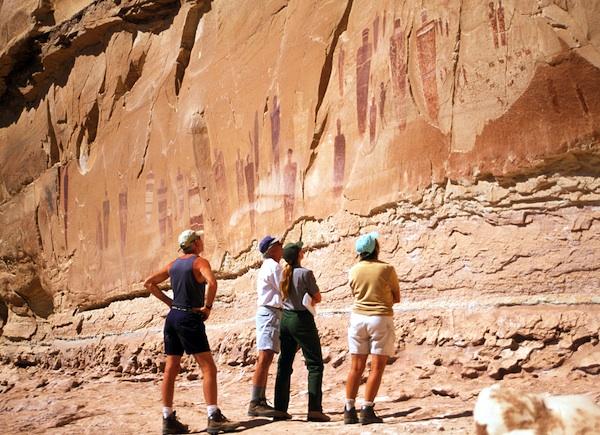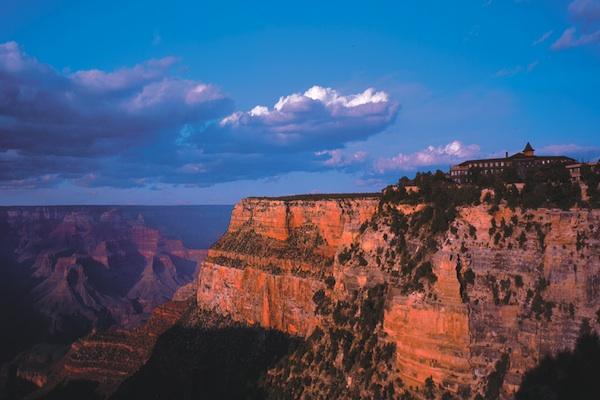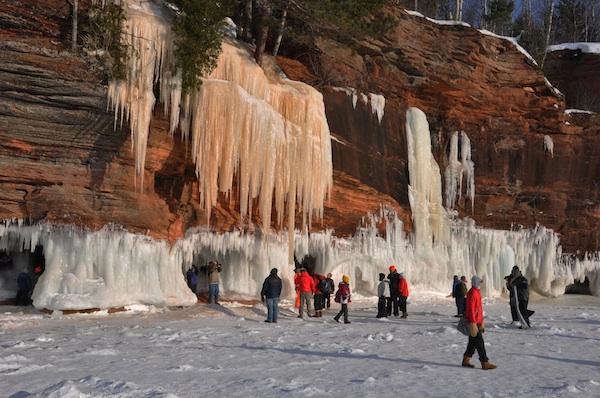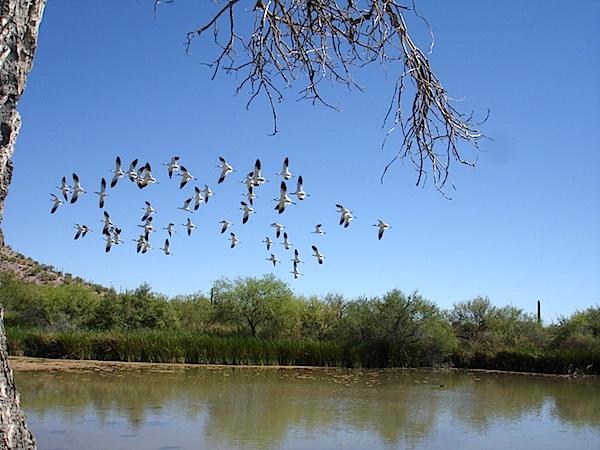
Are national parks becoming irrelevant? That question was one of the big stories in 2014/Great Gallery, Canyonlands National Park by Kurt Repanshek
New units to the National Park System, a face-off over concession fees at Grand Canyon National Park that impacted nearly a quarter of the park system, and even the basic relevancy of national parks were among the top stories of 2014 involving the park system.
Compared to past years, 2014 was relatively calm across the parks. There was no government shutdown. No rangers were killed in the line of duty. No sequestration that further strapped the parks.
Instead we saw Congress create a handful of new park units and redesignate some others. There were wildlife issues, good and bad, vandalism, and ongoing controversies over park management. Here, in not particular order, is a look at the top stories we saw across the National Park System:
* Congress brings seven new units to the National Park System
Before adjourning for the year-end holidays, Congress passed a half-trillion-dollar Defense Authorization bill, and attached to it an array of items to create seven parks, expand some existing parks' boundaries, and call for studies of prospective park units.
New Units of the National Park System
Blackstone River Valley National Historical Park, RI/MA
* Establishes new park unit that will be comprised of specific historic sites and resources within the John H. Chafee Blackstone River Valley National Heritage Corridor, which stretches from Pawtucket, RI to Worcester, MA.
* Park will protect and interpret resources associated with the development of textile mills and other industries in the valley.
* Exact boundaries will be determined by the Secretary of the Interior after sufficient lands are acquired for a manageable unit.
Tule Springs Fossil Beds National Monument, NV
* Establishes new park unit in the vicinity of greater Las Vegas to protect and interpret significant Pleistocene paleontological, scientific, educational and recreational resources.
* Transfers 22,650 acres from the Bureau of Land Management to NPS.
* Allows military overflights over the national monument.
* Authorizes an advisory council.
Valles Caldera National Preserve, NM
* Establishes the existing Valles Caldera National Preserve as a new park unit; the Preserve is a historic ranch with vast natural and cultural resources that lies within a volcanic caldera in the Jemez Mountains.
* Transfers management of the Preserve from the Valles Caldera Trust to the NPS.
* Provides for the continuation of certain activities, such as grazing, hunting, fishing, trapping and traditional use.
* Provides protections for Native American archeological and sacred sites.
* Dissolves the Valles Caldera Trust, provides special hiring authorities for current Trust employees, and governs the transition of assets and liabilities to the NPS.
World War I Memorial, DC
* Redesignates Pershing Park near the White House as the World War I Memorial in honor of veterans throughout the nation who served in that war.
* As a memorial to a major war, the site will be counted as its own unit of the National Park System.
* The District of Columbia World War I Memorial on the National Mall will continue to be dedicated to District residents who served during World War I.
Coltsville National Historical Park, CT
* Authorizes the Secretary of the Interior to establish a new unit to protect and interpret resources associated with the historic Colt arms manufacturing facilities and community in Hartford, CT.
* Will become a new unit after sufficient lands are acquired to constitute a manageable park and other requirements are met.
* Authorizes an advisory committee.
Harriet Tubman National Historical Park, NY
* Authorizes the Secretary of the Interior to establish a new unit to protect and interpret resources associated with the life and work of Harriet Tubman in Auburn, NY, where she lived in her later years, after her Underground Railroad work.
* Will become a new unit after sufficient lands are acquired to constitute a manageable park.
*Will be a companion unit to the Harriet Tubman Underground Railroad National Historical Park on the Eastern Shore of Maryland.
Manhattan Project National Historical Park, WA/NM/TN
* Requires the Secretary of the Interior to establish a new unit to protect and interpret resources associated with the development of the atomic bomb during World War II.
* Will be one unit with sites in three locations: Hanford, WA; Los Alamos, NM, and Oak Ridge, TN.
* Will be established within one year of enactment, after the NPS and the Department of Energy enter into an agreement.
* Will be administered in partnership with the Department of Energy, which will continue to own most facilities.
Park Boundary Adjustments
First State National Monument, DE/PA
* Redesignates as a National Historical Park the national monument established by Presidential Proclamation in 2013 to protect and interpret Delaware's colonial history and its role in the early formation of the nation.
* Authorizes the addition of sites in Wilmington (Old Swedes Church, Fort Christina), Dover (John Dickinson Plantation) and Lewes (Ryves Holt House), if the NPS acquires them.
Harriet Tubman Underground Railroad National Monument, MD
* Redesignates as a National Historical Park part of the national monument established by Presidential Proclamation in 2013 to protect and interpret resources on the Eastern Shore associated with Tubman's work in helping slaves escape to freedom.
* Authorizes the addition of other Tubman-related sites in Talbot, Caroline, and Dorchester Counties, if the NPS acquires them.
* Park will operate in partnership with Blackwater National Wildlife Refuge and Harriet Tubman State Park.
Oregon Caves National Monument, OR
* Adds more than 4,000 acres as a "national preserve" to Oregon Caves National Monument, which now has the "Preserve" addendum to its name.
* Increases park boundary by approximately 4,070 acres; transfers U.S. Forest Service lands to National Park Service to promote protection of critical natural resources and tourism.
Gettysburg National Military Park, PA
* Adds to park boundary the Civil War-era Gettysburg Train Station and 45 acres of environmentally important land at the base of Big Round Top.
* Properties are slated to be donated to the NPS.
Apostle Islands National Lakeshore, WI
* Adds to park boundary the Ashland Harbor Breakwater Light Station, resulting in seven historic light stations and a total of nine light towers being managed by the NPS, more than in any other unit of the National Park System.
Paterson Great Falls National Historical Park, NJ
* Includes within the park boundary the historic Hinchliffe Stadium, one of the few remaining structures associated with the Negro Baseball League in the early- to mid-20th Century.
* NPS will not own the stadium, but will provide assistance in interpreting it.
Lower East Side Tenement National Historic Site, NY
* Adds a second building to the historic site, an affiliated area, which interprets life as an immigrant in New York City in the 19th and early 20th Centuries.
* The historic site is privately run with assistance from the NPS.
San Antonio Missions National Historical Park, TX
* Adds to the park boundary approximately 137 acres of land associated with the historic Spanish missions that are protected and interpreted at this park.
* Lands will be donated to the NPS.
Vicksburg National Military Park, MS
* Authorizes land within three Civil War battlefields (Raymond, Champion Hill, and Port Gibson) to be included in the park boundary, once the National Park Service acquires the land.
* The three battlefields are sites where key conflicts occurred as the Union Army, under General Ulysses Grant, advanced to capture the city of Vicksburg.

Legal battles overshadowed who would run the concessions on the South Rim of Grand Canyon National Park/Xanterra Parks & Resorts
* Xanterra Parks & Resorts vs. the National Park Service at Grand Canyon National Park
Controversy did arise in the park system, in particular at Grand Canyon National Park. Against the failure of long-running efforts to secure a 15-year contract for concessions operations on the South Rim, the Park Service broke the massive concessions contract in two, and tried to make the larger of the two more attractive, and affordable, for businesses by buying down the outstanding $198 million leaseholder surrender interest owed Xanterra Parks & Resorts for decades of investments and maintenance the concessionaire had made in Park Service-owned properties on the South Rim. The first step was relatively easily accomplished, with Delaware North winning the smaller of the two in a deal that requires it to pay Xanterra $41 million in outstanding LSI.
The second step proved trickier, and required 88 units of the park system, and the Washington, D.C., headquarters of the Park Service, to essentially loan Grand Canyon National Park $75 million. The park added $25 million of its own reserves, to make a $100 million payment to Xanterra. With that payment, the outstanding LSI owed Xanterra dropped to $57 million; still a hefty sum, but one the Park Service hoped would not be too staggering to scare off other concessionaires from bidding on the remaining concessions contract for the South Rim, as any company that won the contract would have to pay $57 million to Xanterra.
Xanterra, however, felt wronged by the whole process and sued the Park Service over the concessions contracts. In the end, the Park Service and Xanterra agreed on a one-year temporary contract to run the concessions, which include the El Tover Hotel, the Bright Angel Lodge, and Phantom Ranch, while the Park Service resumes efforts to find a long-term concessions solution.
* Isle Royale National Park Officials Mull Future Of Park's Wolves
2014 was another bad year for wolves on Isle Royale. While an ice bridge did form, linking the island to the Canadian mainland, no wolves came to Isle Royale with a package of new genes. Instead, one female left the island and was later found dead near Grand Portage National Monument. With the distinct possibility that the wolves could blink out due to inbreeding, Park Service officials moved towards a lengthy study to determine how best to address the situation: Should a "genetic rescue" be conducted by bringing wolves to the island, should the current 8-9 wolves be left to their own fate, or should some other solution be adopted?
* Condors Nest at Zion National Park
For the first time in decades California condors came to Zion National Park to nest. Two birds set up housekeeping in a grotto high on one of Zion Canyon's cliffs, and in June a chick was spotted by biologists. But the good news story turned bad in November, when biologists concluded the chick had died.

Ice caves were a huge attraction at Apostle Islands National Park this year/NPS
* The Ice Caves Of Apostle Islands National Lakeshore
There's nothing like a natural phenomena to attract attention, and the "ice caves" at Apostle Islands National Lakeshore in Wisconsin surely did that. Sheets, daggers, and minarets of ice formed by a brutally cold air mass that flooded over Lake Superior in January and into February, transformed the mainland caves into castles of ice that attracted nearly 140,000 people to the lakeshore to marvel at nature's artistic side.
* Gray Wolf Turns Up At Grand Canyon National Park
In something of a modern wildlife miracle, a Rocky Mountain gray wolf wandered south and turned up at the North Rim of Grand Canyon National Park. The journey covered hundreds of miles over at least two states, across mountain ranges and possibly flatlands, across roads and by towns. The wolf, a female with a dead radio collar around its neck, was the first seen in the park in more than seven decades. Without a mate, it might not be long for the canyon.
* Upheaval At National Park Foundation
In a surprising development, Neil Mulholland, the president and chief executive officer for the National Park Foundation, abruptly resigned in late October. It was particularly surprising because the Foundation was entering a "critical phase" for fund-raising keyed to the National Park Service Centennial in 2016. Equally surprising was his replacement: Yellowstone National Park Superintendent Dan Wenk.
* Vandal Paints The National Parks
Though she apparently thought it novel at the time, a New York woman who fancied herself an artist took acrylic paints and doodled images on rock faces and cliffs across the western half of the National Park System. National Park Service investigators confirmed that images were painted on rocks and boulders in Yosemite National Park, Death Valley National Park, and Joshua Tree National Park, all in California; Rocky Mountain National Park and Colorado National Monument, both in Colorado; Crater Lake National Park, in Oregon; Zion National Park and Canyonlands National Park, both in Utah.
Despite the tracks she left behind, the matter was still progressing through legal channels in December.
* Drakes Bay Oyster Co. Leaves Point Reyes National Seashore
A decades-long history of oyster farming at Point Reyes National Seashore in California came to an end in 2014 when the owners exhausted their legal options for forcing the National Park Service to renew their lease. The battle, which went all the way to the U.S. Supreme Court, marked an end to Drakes Bay Oyster Co., which had been using the waters of Drakes Estero to raise oysters longer than the national seashore had been in the park system. Key to the battle was a contract that said the lease would expire in November 2012. When that month surfaced, then-Interior Secretary Ken Salazar declined to renew the lease and National Park Service Director Jon Jarvis immediately designated the estero as part of the seashore's official wilderness.
There, up in the sky! It's a bird! It's a plane! No, it's a remote controlled drone, and it's crashing into one of Yellowstone National Park's most renowned hot springs. The crashing, and loss, of a drone into Grand Prismatic Spring in Yellowstone, and other drone sightings in Zion National Park, where one buzzed desert bighorn sheep, and at Grand Canyon National Park, where one buzzed visitors, prompted the National Park Service to ban the aircraft in the park system.
Not everyone got the message, though, as there were later drone sightings, and prosecutions.
* Organ Pipe Cactus National Monument Fully Opens To The Public

For the first time in more than a decade all of Organ Pipe Cactus National Monument, including the Quitobaquito area, was open to the public/NPS
In a sign that border safety is improving, Organ Pipe Cactus officials in September opened all 330,689 square acres of the monument to the public. A large swath of the park along the southern Arizona border with Mexico was closed to the public in 2003 after a park ranger, Kris Engle, was killed by members of a drug cartel.
* Debate Over ORVs Continued At Cape Hatteras National Seashore
Debate continued in 2014 over whether off-road vehicles and sea turtles and piping plovers could safely co-exist on the thin strip of Cape Hatteras beaches that comprise a good portion of North Carolina's Outer Banks. Legislative efforts aimed at forcing the National Park Service's hand in managing the vehicles in the best interests of the turtles and birds ended in December when that massive defense authorization bill carried an amendment that asks the Park Service to consider modifying the current management plan in terms of night beach use and the distance ORVs and pedestrians must keep from turtle nests and those of piping plovers.
* Backcountry Fee At Great Smoky Mountains National Park
You wouldn't think a $4 fee for sleeping on the ground would cause much ruckus, but at Great Smoky Mountains National Park the decision to levy such a fee on backcountry travelers, up to a maximum of $20 per trip, and to create an on-line reservation system for campsites has spawned a legal drama that could have wide-ranging impacts. Even before a trial is scheduled to hear the case the lawsuit by a group calling itself Southern Forest Watch has uncovered illegal work by a private resort bordering the park to keep open hiking trails the park has largely abandoned. In its lawsuit, the group argued that a section of the National Park Service Organic Act states "no natural curiosities, wonders, or objects of interest shall be leased, rented, or granted to anyone on such terms as to interfere with free access to them by the public..."
* The National Park Service vs. Alaska Over Predator Control
While state officials in Alaska view wolves and bears as predators that take an unhealthy cut into the prey that brings more than a few hunters into the state, the National Park Service takes seriously its role as maintaining healthy prey and predator populations. Those two views clashed this year. In February employees with the Alaska Fish and Game Department wiped out an entire wolf pack from Yukon-Charley Rivers National Preserve.
The pack had been monitored by Park Service researchers since 2007 as part of a decades-long ecological study. "Removal of the Lost Creek pack follows similar losses from ADF&G predator control efforts last spring which killed 36 wolves in the area, reducing the population using the preserve by more than half," Park Service officials said.
In a bid to halt similar killings, the Park Service late in the year moved to enact a permanent federal prohibition against certain hunting practices. The aim was to prevent the hunting of wolf and coyote pups and adults in early summer when they den and their pelts have little commercial value; prohibit the taking of brown bears over bait, and; prohibit the use of artificial light to take black bear cubs and sows with cubs at dens.
* National Parks Are Becoming Irrelevant
Are national parks becoming irrelevant? It's a question that Park Service Director Jon Jarvis raised with the Traveler during a discussion in March. The comment was made in response to a question over how certain politicians in Congress view the National Park Service and System, and their efforts to undercut both.
'Here's what I think about all this congressional and other action: I think it's a symptom of a waning relevancy of the national parks to the American people," Director Jarvis said. "Which is why I go back to the centennial and our opportunity to rebuild that relationship.
"... What I sense, in terms of the flattening of (annual park) visitation, the flattening of the budget, these sort of legislative attacks on the underpinning of the Service, the challenges that we're facing on a variety of fronts, are symptoms, to me, of a waning relevancy to the American people. And a lack of understanding of really what the Park Service provides to society," he said.
Secretary Sally Jewell raised the same concerns in November during a short interview with another media outlet.
"We need to make national parks relevant to new generations, to connect to people who have less time for a road trip or weekend campout with kids," she said.



Comments
And Great Smoky Mountains National Park gets a new superintendent after 13 months
Welcome, Cassius Cash! The new Superintendent will start in February.
Danny Bernstein
www.hikertohiker.com
I can't help but wonder if the long delay in securing this new superintendent was to let some of the dust settle on the backcountry fee scandal. The previous administration allowed a private resort to maintain and operate their own trail system in the park. I hope they vetted this new guy properly because the spotlight is shining on the misdeeds at Sugarlands and legacy of Ditmanson.
Great Goddess, backpacker.
Can you look at a kitten or butterfly without a gloomy sinister conspiracy theory? Sheesh.
And here are the top 10 Acadia National Park news stories in 2014, as reviewed for our latest blog post: www.acadiaonmymind.com/2014/12/year-review-top-10-acadia-national-park-s...
* Debate Over ORVs Continued At Cape Hatteras National Seashore
Debate continued in 2014 over whether off-road vehicles and sea turtles and piping plovers could safely co-exist on the thin strip of Cape Hatteras beaches that comprise a good portion of North Carolina's Outer Banks. Legislative efforts aimed at forcing the National Park Service's hand in managing the vehicles in the best interests of the turtles and birds ended in December when that massive defense authorization bill carried an amendment that asks the Park Service to consider modifying the current management plan in terms of night beach use and the distance ORVs and pedestrians must keep from turtle nests and those of piping plovers.
Although the above is certainly a big part of this bill another aspect is just how the "primitive wilderness" aspect of this park's EL will be addressed. The proponents of this bill are ORV users. More ORV access is the goal of this bill. From my perspective nothing else is of much importance other than that.
SEC. 3057. CAPE HATTERAS NATIONAL SEASHORE RECREATIONAL AREA.
Rick B. President of the NPS can do no wrong club. Must be nice to live in that land of sugarplum fairies and Smoky Bear all the time. As for those of us who don't drink the NPS kool aid and have no financial ties to the agency, we will continue to question regardless of the arrows from your ilk.
And the huge debate about potential doubling of entrance fees is completely ignored.
What a drama queen. The reality is, the use of junk science to manage birds and turtles will be difficult to use now. There will still be protections for birds and turtles, like there has been since inception of the seashore recreational area. The NPS will now have to consult with "local" State wildlife agency, which dhould be interesting since they don't require closures at all for most threatened species. This will open up a lot of closed beaches and prevent the stupidity we saw last year, with closures right in front of rental houses.
Buxton, there is no primitive wilderness on Hatteras Island, there isn't anything to be addressed. You can pretend all you want it's there, but most the island has been altered by man.
I'd like to see most of the new VFAs removed, especially between ramp 34 and ramp 23. Maybe make some seasonal. There should be a time, even if it's winter, that I can drive from Rodanthe to Hatteras Village. Shorten or eliminate the night time ORV restrictions will be good too. It's all a good start to regain reasonable access to the recreational area.